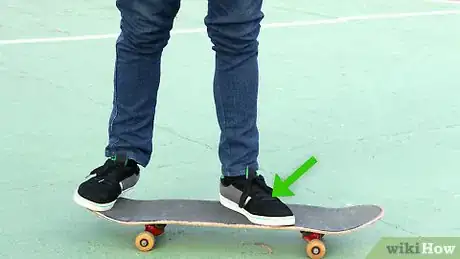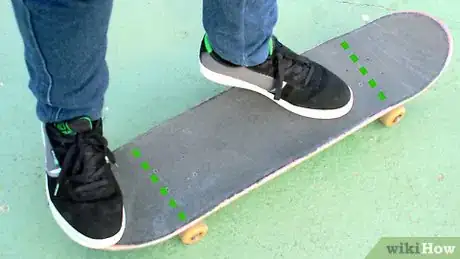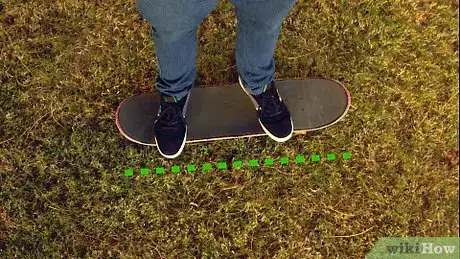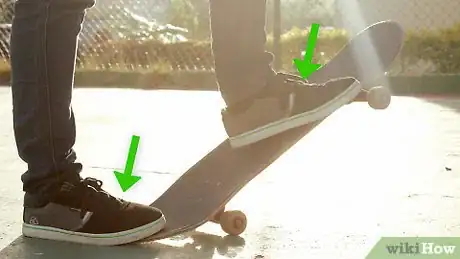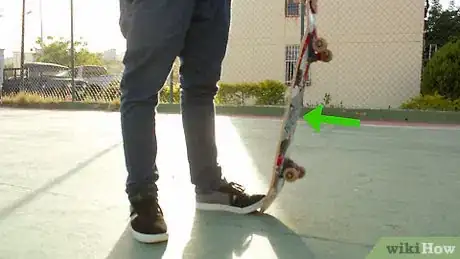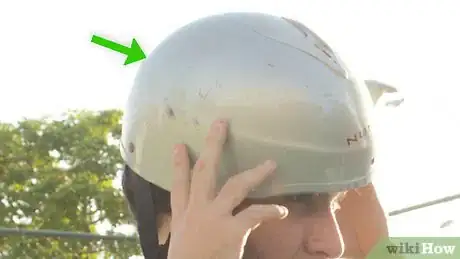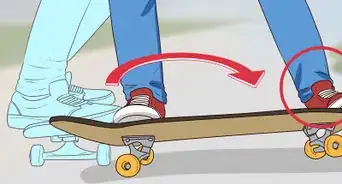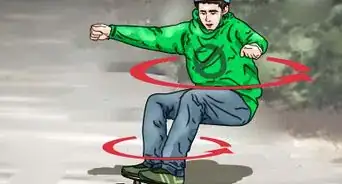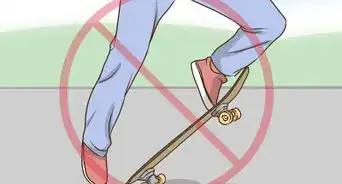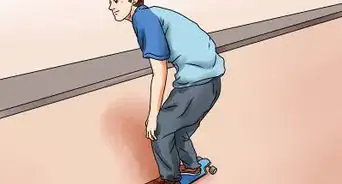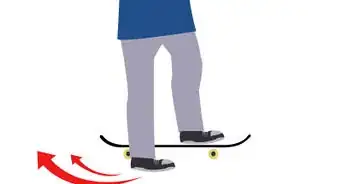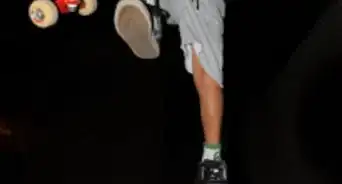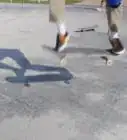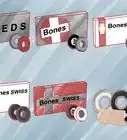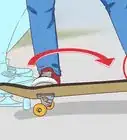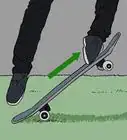This article was co-authored by Jon Depoian. Jon Depoian is a Skateboarding Instructor and the Owner of Intro2Skateboarding, an organization based in Orange County, California that provides professional private, home-school, after-school, birthday party, and summer camp skateboard lessons for beginners and experienced skateboarders alike. Jon has over 21 years of skateboarding experience and over 10 years of skateboard instruction experience. He also has extensive experience producing street skateboarding videos and skating competitions.
There are 9 references cited in this article, which can be found at the bottom of the page.
This article has been viewed 451,090 times.
Are you trying to learn how to ride a skateboard? One of the toughest parts of learning to ride a skateboard is learning how to balance on the board. Improving your ability to balance on a skateboard takes patience and practice, but using some special strategies to improve your balance and getting the right gear can help you on your way.
Steps
Working on Your Balance
-
1Determine your preferred stance.[1] It is important to find and use your preferred stance to balance on a skateboard. The two main positions that skateboarders use are called regular and goofy. Try out both positions to see what feels the most natural to you.
- If your left foot is forward, or you are facing to the right you are in the position called "regular". If your right foot is forward, or you are facing to the left you are in the position called "goofy".
-
2Place your feet just behind the bolts. Make sure that when you stand on the skateboard, your feet are positioned just behind the bolts.[2] This is the best way to position your feet for good balance. Placing your feet in the middle of the board will not give you as much control and it also makes it easier to break your board.
- The bolts are what is securing your skateboard’s wheels to the board, so your feet should be just behind the wheels on your board.
Advertisement -
3Stand on your skateboard on carpet or grass. Before you try to balance while riding your skateboard, start by balancing on your skateboard while it is standing still. The easiest way to keep your skateboard from rolling around too much is to place it on some carpet or grass.[3] Then, stand on your skateboard and work on your balance.[4]
- You can also try placing an object in front of and behind the wheels on your skateboard to keep it from moving around too much. Try placing a block of wood on either side of your skateboard, or position the board between two cinder blocks.
- If you still find it difficult to stand on the board even when it is not moving, then you might try holding onto a railing or a wall to steady yourself and work up to standing on the board without holding onto anything.
- One option is to have a friend hold your hand slightly higher than your waist, so you can still feel the movement of the wheels but also have something to brace yourself on.[5]
-
4Work on your balance by shifting your weight. You do not need to lean back and forth or move much at all to work on your balance. Just try to keep your body weight centered and shift your weight slightly from your heels to your toes to stay stable on the board.[6]
- Keeping a slight bend in your knees is also a good idea. This will help to keep your center of gravity lower to the ground, which will make it easier to balance.
- To improve your balance, you will need to practice balancing on the board often. Try to practice for at least 15 minutes every day.
- You can also try to tighten your bearings so the wheels roll slower, if at all. Then you can practice getting on and off the board without worrying about slipping out on the wheels.[7]
Balancing on a Moving Skateboard
-
1Practice pushing off on a level surface. When you feel ready to try balancing on a moving skateboard, start with something easy such as a level stretch of concrete. Position your front foot on the board and place the other foot on the ground just in front of that foot. Then, use your foot to push on the concrete and move your board and body forward.[8]
- Keep a low center of gravity as you push. Bend your knees and balance your body weight over the foot that is on the skateboard.
- Find a flat sidewalk or visit your local skate park to find a flat surface that is away from traffic.
- If you do decide to try skating on a surface with an incline, make sure that the incline is low to avoid losing control of the board.
-
2Place the other foot on the board. After you push off, you will need to bring your pushing foot up and onto the board.[9] Remember to place this foot behind the bolts on your board and keep it turned sideways. This will make it easier to balance on the board because you will be able to rock back and forth on your foot in a more stable way.
- Keep your front foot planted as you bring the back foot onto the board if you push "regular"
- Keep your back foot planted as you bring the front foot onto the board if you push "mongo"
-
3Stay on the board until it stops. After you get positioned on the moving board, ride it and do your best to stay balanced until it comes to a stop on its own.[10] If you are on a flat surface, then this should not take very long.
- If you have decided to try riding your board down a hill, then this may take a little longer and you may even need to stop yourself if you start to feel unstable. To stop the board, use your back foot to step on the tail of the board. This will cause the tail to grind against the ground and come to a stop.[11]
-
4Use your heels and toes to turn the board. You can experiment with turning the board while you are practicing riding it. To turn the board, simply shift your weight slightly from one side of the board to the other.[12]
- For example, if you shift your weight to your heels, then the board will shift to the right or left depending on which direction your heels are facing. If you shift your weight to your toes, then your board will turn in that direction.
- Your center of balance should be directly between your two feet to do this exercise. Bend your knees keep your arms outward the arms should be just outside of each of your feet now doing one foot at a time.
Choosing the Right Gear
-
1Wear skate shoes. You can skateboard in sneakers, but skate shoes are specially designed to help you stay on the board. Skate shoes are wider than regular sneakers, so they make more contact with the board. The width of skate shoes may also make it easier for you to keep your balance on the board.[13]
- You can find skate shoes in most sporting good stores and department stores.
-
2Consider getting a custom made skateboard. Skateboards are widely available, but you may want to consider getting a custom made skateboard, or at least purchasing one from a skateboard shop. This will allow you to ask questions and get help from people who are knowledgeable about skateboarding and skateboards. You can get advice on the best type of skateboard for your abilities and needs.[14]
- For example, you may prefer a skateboard that can be used on dirt rails for mountain boarding, or you may just want one that can be used in a skate park and on sidewalks.
- By getting a skateboard that is customized for your needs, you may have an easier time of balancing on your skateboard.
-
3Wear a helmet and protective padding. Skateboarding can be a dangerous sport, so it is important to protect yourself by wearing the proper gear.[15] Always wear a helmet, wrist guards, and elbow pads when you are skateboarding. Wearing these special items will help to protect you when you fall, which happens often when you are first learning how to skateboard.[16]
- Make sure that you wear a helmet that meets the ASTM F1492 standard for skateboard helmets. Check the tag on the helmet to be sure.
- While wearing protective gear will not help you to balance on the board, it may help you to feel more confident because you will be less likely to get a serious head injury or a broken wrist.
Expert Q&A
Did you know you can get expert answers for this article?
Unlock expert answers by supporting wikiHow
-
QuestionHow do you practice balancing on a skateboard?
 Jon DepoianJon Depoian is a Skateboarding Instructor and the Owner of Intro2Skateboarding, an organization based in Orange County, California that provides professional private, home-school, after-school, birthday party, and summer camp skateboard lessons for beginners and experienced skateboarders alike. Jon has over 21 years of skateboarding experience and over 10 years of skateboard instruction experience. He also has extensive experience producing street skateboarding videos and skating competitions.
Jon DepoianJon Depoian is a Skateboarding Instructor and the Owner of Intro2Skateboarding, an organization based in Orange County, California that provides professional private, home-school, after-school, birthday party, and summer camp skateboard lessons for beginners and experienced skateboarders alike. Jon has over 21 years of skateboarding experience and over 10 years of skateboard instruction experience. He also has extensive experience producing street skateboarding videos and skating competitions.
Skateboarding Instructor You can practice balancing on grass or carpet so your board doesn't roll everywhere. You can also tighten the wheels down so they roll slower. Then you can practice getting on and off without worrying about slipping out on the wheels. If you're ready for wheels, try bracing yourself against something that's a bit more than waist-high to get you used to balancing.
You can practice balancing on grass or carpet so your board doesn't roll everywhere. You can also tighten the wheels down so they roll slower. Then you can practice getting on and off without worrying about slipping out on the wheels. If you're ready for wheels, try bracing yourself against something that's a bit more than waist-high to get you used to balancing. -
QuestionCan you wear sneakers while on a skateboard?
 Community AnswerYes, but it becomes much more challenging. Pads are recommended until you've gotten the hang of it.
Community AnswerYes, but it becomes much more challenging. Pads are recommended until you've gotten the hang of it. -
QuestionShould I stop trying if I can not balance myself or ride the skateboard?
 Community AnswerDon't ever stop trying. I've seen people take months just to be able to ride a board. The more you skate, the more it'll become natural to you.
Community AnswerDon't ever stop trying. I've seen people take months just to be able to ride a board. The more you skate, the more it'll become natural to you.
Things You'll Need
- A Skateboard
- A helmet
- Knee and elbow pads
- Skate shoes
- Wrist guards
References
- ↑ http://www.awesome-skateboard.com/Beginners.html
- ↑ http://www.board-crazy.co.uk/skateboarding_beginners_1.php
- ↑ Jon Depoian. Skateboarding Instructor. Expert Interview. 5 June 2020.
- ↑ http://www.awesome-skateboard.com/Beginners.html
- ↑ Jon Depoian. Skateboarding Instructor. Expert Interview. 5 June 2020.
- ↑ http://www.awesome-skateboard.com/Beginners.html
- ↑ Jon Depoian. Skateboarding Instructor. Expert Interview. 5 June 2020.
- ↑ http://www.board-crazy.co.uk/skateboarding_beginners_1.php
- ↑ http://www.board-crazy.co.uk/skateboarding_beginners_1.php
- ↑ http://www.board-crazy.co.uk/skateboarding_beginners_1.php
- ↑ http://www.board-crazy.co.uk/skateboarding_beginners_1.php
- ↑ http://www.board-crazy.co.uk/skateboarding_beginners_1.php
- ↑ https://coolerlifestyle.com/features/beginners-guide-skateboarding.html/3#kUfoxOXqmRV4UqFt.97
- ↑ https://coolerlifestyle.com/features/beginners-guide-skateboarding.html
- ↑ http://kidshealth.org/en/teens/safety-skateboarding.html
- ↑ http://kidshealth.org/en/teens/safety-skateboarding.html#
- Videos provided by TYT Sports
About This Article
Balancing on a skateboard can be tricky at first, but with the right posture and a little patience, you’ll soon get the hang of it. Make sure your feet are behind the bolts that hold the wheels on, which will give you the best control over your board. Bend your knees slightly, since this keeps your center of gravity lower to the ground and makes balancing easier. Try practicing balancing on the board while it’s standing still. This will help build your confidence and reduce your chances of falling. Try shifting your weight from your heels to your toes and back to get used to the feeling. When you’re ready to get moving, start with one foot on the board and the other hovering over the ground so you can easily stop yourself if you go too fast. Then, get used to riding with both feet on the board. For more tips, including how to turn on a skateboard, read on!
